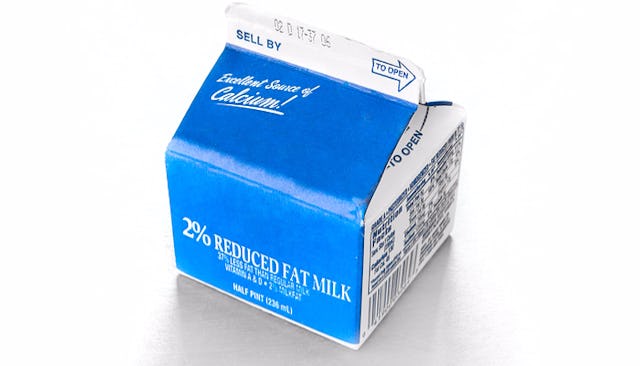Student Faces Charges For 'Stealing' 65-Cent Carton Of Milk He Was Entitled To

Dumfries, Virginia, Graham Park Middle School student Ryan Turk just wanted what he got every day: a 65-cent carton of milk, courtesy of the free lunch program. He’d forgotten to grab one on his first trip through the cafeteria line, so he got up to get another. He and his mother, who saw surveillance footage of the incident, say he got his milk and sat down.
That’s when the trouble started.
The school resource officer (SRO) appeared, and accused Ryan of stealing the milk. According to The Washington Post, Ryan “said that he put the milk back but that the officer told him to pick up the carton and take it to the principal.” The SRO grabbed him by the neck. Then he handcuffed Ryan and charged him with disorderly conduct and petit larceny. He refused non-judicial intervention because, as his mother says, he didn’t do anything wrong. Instead, he will face misdemeanor criminal charges just before his 15th birthday.
The SRO, who had other juvenile hearings scheduled the same day as Ryan’s, tells a different tale. He says Ryan cut in line and told him he was stealing. Then Ryan threw the milk back. The SRO said he needed to speak with the principal, and Ryan “became disorderly,” a spokesperson told the The Washington Post. He pushed the officer, and as they approached the principal, the boy tried to “push past the officer to get away.” Only then was he cuffed and charged.
Prince William County notes that Ryan is black, and so is the SRO and the principal involved. But as Turk’s lawyer Emmett Robinson says,“It’s not the players, it’s not the people who discriminate; it’s the whole system. The system is set up now so that school resource officers get to determine the impact on a person’s life.”
We’ve seen it before: the omnipresent of police officers in schools leading to police overreach and violence. As school shootings become normalized, says Shaun King in “America’s People of Color Aren’t Even Safe From Police Violence in Schools,” “the presence of police in elementary, middle, and high schools has become as normal as police on the street.” According to the National Center for Education Statistics, 64% of all American public high schools have one or more security guards, security personnel, SROs, or other sworn police officers on campus at least once a week. And it’s not all Officer Friendly.
The Washington Post notes that black students in Richmond “recently filed a civil rights complaint against their school district, alleging that discipline practices there are unfair.” Critics, including Black Lives Matter, claim that students of color are unfairly targeted for harsher discipline than their white counterparts. The stats stand up: According to the U.S. Department of Education, in conjunction with the Department of Justice, half of all students arrested or referred to law enforcement are black or hispanic. In some Southern school districts, African-American students are suspended at five times the rate of whites.
We all remember the African-American girl thrown from her desk by an SRO at South Carolina’s Spring Valley High School. The teacher had asked her to leave, and she had refused. The SRO was called in. And when she still refused to leave, SRO Ben Fields grabbed her “so hard that he upturned her desk. He then threw her across the floor and subdued her.” Later, news emerged that the child was in foster care.
Mother Jones collected data to show that in the past five years, “over 28 students have been seriously injured, in one case shot to death, by so-called school resource officers — sworn, uniformed police assigned to provide security on K-12 campuses.” The list of injuries reads like a Black Lives Matter report on police brutality. One boy was put in a chokehold and suffered a brain injury; another was beaten with a baton (the district admitted no wrongdoing, and the officer in question still has his job); and a taser-induced severe brain injury that left a student in a medically induced coma. The student was attempting to break up a fight.
Ryan Turk’s lucky his SRO only grabbed him by the neck.
His case, like the others, shows the increased danger of police presence in schools. Ryan’s lawyer, who claims his case is related to institutional racism, stated, “This officer treats kids like they’re criminals, and guess what happens — they’re going to become criminals.” In “Preparing for Prison: The Criminalization of School Discipline in the USA,” Paul J. Hirschfield found that having cops in schools leads to “increased ticketing and arrests for minor infractions.” Officers step into matters of routine student discipline, including, as one Virginia lawyer says, “minor scuffles […] or even just talking back.” This is exactly what happened to Ryan.
If we continue to have police in schools, especially police untrained in conflict resolution, deescalation, and the proper use of force, we’ll continue to see incidents like Ryan’s, where a kid was roughed up and faces criminal charges over a 65-cent carton of milk. There are certainly good SROs, but there are certainly bad ones too, and they disproportionately target students of color.
The NRA continues their call, which began after Sandy Hook, to place SROs in every school in America. We don’t need the NRA making decisions for us. SROs disproportionately target students of color for harsh punishment. That’s not what we want for our children. That’s not what we want for America.
This article was originally published on